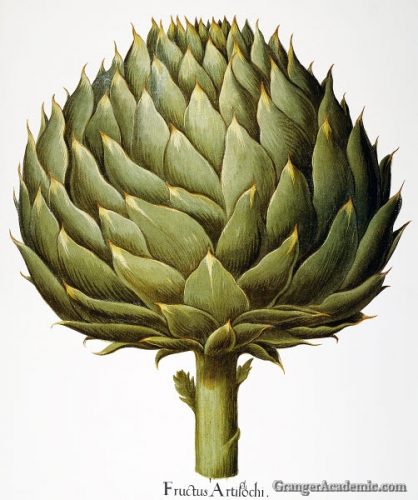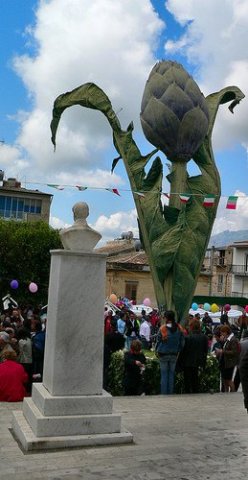
ARTICHOKE, 1613.
Italian artichoke head (Cynara scolymus): engraving from Basilius Besler’s ‘Florilegium,’ published in Nuremberg in 1613.
Isn’t modern life utterly exhausting?
The traffic, the schedules, the meetings, the constant communications. At least, it was. These days, it seems to be exhausting in a completely different way.
I could make the argument that life is more exhausting now than it was just a year ago. And there are those who recall “simpler times,” decades ago when life didn’t seem so complicated. But, wasn’t it?
Hasn’t the grind of life always worn us humans down, no matter the era or generation?
Herbal enthusiast, futurist, and Italian businessman Angelo Delle Molle certainly thought that humankind needed a pick-me-up, a reprieve, from the demands of modernity even in the 1950s (i.e. “the good ol’ days”). It was then that he concocted a bitter, herbal liqueur featuring the stately artichoke. He named the spirit Cynar, from the shortened Greek for its genus, Cynara.
And the motto he chose to promote the spirit?
Contro il logorio della vita moderna.
“Against the strain of modern life.”
Modern life, eh?
Decades later, Cynar has emerged as one of the most recognizable spirits in the amaro category of herbal, bitter liqueurs. These dark, coffee-colored infusions have been created since the Middle Ages, particularly in Italian villages where they are still popular today.
There are redeeming qualities to Molle’s approach, which was rooted in a respect for not only the healing aspects of nature but also the technological advancement of humanity. Futurist that he was, he wrestled with and exposed this juxtaposition of human needs throughout the brand, offering Cynar as a median between the demands of the present and future.

Cynar is the premier bitter amaro made from artichokes
Because of the mild taste of the artichoke heart and the contrasting bitter flavor of the spirit, it’s obvious after a taste that it is the medicinal leaves of the plant itself that are used to flavor Cynar, not the meaty, sought-after heart of the flower bud. It’s important to distinguish between the succulent, edible bracts, or specialized leaves, that surround the heart and the large, spiny leaves attached to the stalk. Traditional herbal medicines consistently cite the raw, green artichoke plant’s leaves, which are dried and ground, as the source of the drying, astringent taste that imparts a bracing flavor. Traditional medicines widely regard artichoke leaves as therapeutic, but how much of the beneficial properties are infused into the spirit is questionable (and unfortunately not required to be reported). It’s best to enjoy Cynar as an exploration of the bitter taste and an adventure for your palate, not as a health tonic of any sort.
There are two popular species of Cynara: scolymus, which is the globe variety with the delicious edible heart, and cardunculus, the lesser known “wild artichoke” that is mostly enjoyed by Silicians. We’ll discuss the wild variety, better known as cardoons, a bit later, but for now let’s dig into our common market variety globe artichoke.

A larger than life monument to the artichoke is in the town square in Cerno, Polermo, Sicily
Overall, there are about 50 varieties of the globe artichoke, usually becoming available in March – May with another harvest season in the fall. Revered and enjoyed in ancient Rome and Greece, the artichoke is thought to have been perfected in northern Africa and brought to Europe by Arabs where it was embraced and has been celebrated ever since. Evidence of this is obvious in modern day Sicily, which hosts an annual artichoke festival every April and has even erected a large monument in the town square of Cerda, in the metropolis of Polermo. Surrounded by fields of the famed thistle, the farmers here are largely supported by this crop, as they are thousands of miles away in Castroville, CA, a humble town that boasts a less-glamorous but still impressively sized artichoke landmark.
The heart of the artichoke is the pre-fruit aspect of the plant, before the fruit bursts into full flower form. The tiny hairs inside develop into a beautiful thistle flower with a purpleish hue if left to bloom on the plant. Some say those hairs are inedible, but I learned that some people actually enjoy eating them, so the last time I steamed arties, I tried them. They are quite tasty!
Interestingly, the flower bud of the cardoon is ignored and is harvested for its fibrous stalks, which are processed and chopped into a variety of savory dishes, but mostly for a type of fritter. The flavor and texture of the stalks is said to be very close to that of Burdock, which is used as a substitute in these recipes.

St. Joseph’s Day altar at the Church of St. Peter and Paul in New Orleans, LA
In New Orleans, it is customary for cardoon fritters to be one of the offerings left on the elaborate altars that are built in every Catholic church to observe St. Joseph’s Day, March 19. And if you can’t find cardoons, you can substitute Burdock.
The cardoon made its way into royalty centuries ago, when the Knights of Cardone were established in 1370 in France and went on to be re-established centuries later in Scotland, when the organization was renamed The Order of the Thistle. Under Elizabeth II today, this Order is the second highest under the British crown and is the main reason that the thistle flower is the traditional symbol of Scotland.
I’ve long been fascinated with thistles of all kinds. They are such striking plants with their spiky leaves and flower buds that look like the tip of a spear. If you look through ancient emblems, crests, and iconography, you’ll see thistles of some kind appear again and again so clearly I’m not the only one impressed by them.
Have you experimented with artichokes or cardoons? What about burdock? Have you tried Cynar or any other artichoke liqueur?